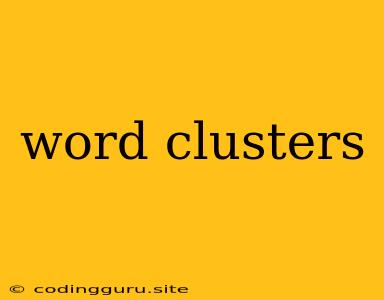Understanding Word Clusters: A Key to Text Analysis and NLP
Have you ever wondered how computers understand the meaning of text? How do they differentiate between "bank" as a financial institution and "bank" as a riverbank? This is where word clusters come into play.
Word clusters, also known as word groups or semantic clusters, are groups of words that share a similar meaning or are related in some way. They are a fundamental concept in natural language processing (NLP), and their understanding is key to unlocking the complex world of text analysis.
Why are Word Clusters Important?
- Meaning Disambiguation: They help computers understand the different meanings of words, resolving ambiguity and improving the accuracy of NLP tasks.
- Text Similarity: By comparing the word clusters present in different texts, we can determine their semantic similarity, which is crucial for tasks like document clustering and information retrieval.
- Topic Modeling: They help identify the main topics discussed in a text, allowing for better understanding and analysis of large amounts of data.
- Machine Learning: Word clusters are often used as features in machine learning models for tasks like sentiment analysis, text classification, and question answering.
How are Word Clusters Created?
There are various methods for creating word clusters, each with its own strengths and weaknesses:
- Co-occurrence-based: This method groups words that frequently appear together in text, suggesting a semantic relationship. For example, "apple", "banana", and "orange" might be clustered together as they often appear in the context of "fruit".
- Distributional Semantics: This method leverages the idea that words with similar meanings often appear in similar contexts. For example, words like "beautiful", "gorgeous", and "stunning" might be clustered together as they are often used to describe beauty.
- Hierarchical Clustering: This method starts with individual words and iteratively groups them based on their semantic similarity, creating a hierarchy of clusters.
- K-Means Clustering: This method aims to partition words into a predefined number of clusters, based on their distance from cluster centroids.
How to Use Word Clusters in Your Work
Word clusters can be a powerful tool for anyone working with text data, whether you're a data scientist, linguist, or content creator. Here are some practical applications:
- Improving Search Results: Using word clusters, search engines can better understand user queries and return more relevant results.
- Personalizing Content: Recommending articles or products based on the user's interests and past behavior, by analyzing the word clusters present in their browsing history.
- Automating Content Creation: Generating text summaries, translations, or even creative content based on the relationships between words within word clusters.
Examples of Word Clusters
Here are some examples of word clusters in different domains:
- Technology: "smartphone", "laptop", "computer", "software", "hardware", "internet"
- Finance: "stock", "bond", "investment", "market", "risk", "return"
- Healthcare: "doctor", "hospital", "patient", "medicine", "disease", "treatment"
Challenges with Word Clusters
- Contextual ambiguity: Some words can belong to multiple word clusters depending on the context. For example, "run" can refer to running a business or running a race.
- Subjectivity and personal interpretation: Different people might have different interpretations of the meaning of a word, leading to variations in word cluster construction.
- Dynamic language: The meaning of words can change over time, requiring constant updates to word clusters to maintain accuracy.
Conclusion
Word clusters are a powerful tool for understanding and analyzing text data. They provide a structured way to group words with similar meanings, allowing for better text analysis and more efficient NLP applications. While challenges remain, the advancements in NLP and the continued research on word clusters hold immense potential for future applications.
